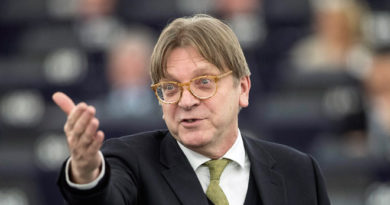
Next stop: political innovation
Governments can exercise their power in two main ways: on the one hand, by imposing rules and regulations, and on the other, by distributing or extracting money through instruments like subsidies and fines. The European Green Deal is built on the very same foundations. It aims to usher in a cleaner and more sustainable way of life. The European Commission wants to curb greenhouse gas emissions by using an unprecedented amount of legislation, mainly under the umbrella of the Fit for 55 package and the Green Deal.
The Commission is ploughing ahead by combating undesired practices and initiatives, for instance through the establishment of the Emissions Trading System (ETS) and the effective ban on the sale of combustion-engine cars as of 2035(1), and by subsidising green technology innovation on a more modest scale.
The USA has chosen a different path. Instead of clamping down on unwelcome practices, it is fast-tracking desirable developments. Through this alternative strategy, as exemplified by the Inflation Reduction Act(2), the US Government is supporting and subsidising businesses and innovation. This should prompt the EU to reconsider its own strategy.
Brake or accelerator
In my work with Parliament’s Committee on Transport and Tourism, I have often wondered about the Commission’s approach to tackling climate change in the transport sector. The sector is responsible for vast greenhouse gas emissions in Europe every year: for example, in 2019, the last year before the pandemic, it generated 835 million tonnes of CO2 equivalent, accounting for 28.5 % of the total emissions in the EU(3). Given this significant contribution to emissions, it is only natural for the Commission to pay attention to the sector – especially since demand for transport is expected to continue steadily rising in Europe in the future, driven by population growth.
Indeed, according to estimates, freight(4) and passenger(5) transport demand will respectively grow by 30 % and 25 % by 2040. If we do not act, emissions of greenhouse gases will soar. In transport, as is the case for energy, there is no need to reinvent the wheel because technology for clean energy and clean transport already exists, albeit it can still be improved.

Taking the resilience dimension of transport into account, a pan-European high-speed rail (HSR) network can play a role in overcoming the airport capacity challenge. The European Organisation for the Safety of Air Navigation (Eurocontrol) forecasts a capacity gap at European airports of 1.5 million flights in 2040(6). Meanwhile, the number of short-haul plane journeys (under 500 km) reached 2.7 million in 2019, representing 24 % of the total flights departing from Europe(7).
If we shift to rail in Europe, we can make transport cleaner, safer and accessible to all. The train literally leaves nobody behind.
It goes without saying that HSR is clean. For example, for a 600 km trip, carbon emissions from HSR are 8 times lower than travelling by car and 11 times lower than flying(8). So, why are the EU and the Member States not investing more in such a clean mode of transport for cross-border travel?
Unlike for air and road transport, it should be noted that the onus is on the Commission to manage international rail transport and facilitate green development in this area, given the national-oriented, state-owned environment and the lack of open and fair competition.
Nevertheless, the Commission and its counterparts at national level (the Member States) are still using restrictive instruments to get things done. They seem to believe that prohibition and legislation are the only ways to boost the green transition. They trust in the power of curbing through fines and ‘politics-as-usual’ practices as the silver bullet (rather than a bullet train) for the current transport challenges. Policymakers and politicians are still basing their action on the political instruments of the past. However, a ‘European Inflation Reduction Act’ is needed for the development of a connected Europe via HSR.

A real pan-European HSR network that contributes to a more sustainable future can only be established through a European approach, and specifically an EU agency that has the responsibility for creating high-speed cross-border connections and the authority to do so. An agency with a budget that fits the challenge. An agency with a vision, a plan and a road map. Only the EU can create such an agency, which should also be responsible for ensuring a level playing field for daily operations.
The EU grants its citizens the right to move freely across borders. As a result, it is also responsible for helping European passengers to make use of that right.
So, is it time for ‘political innovation’? The obvious answer is ‘yes’, because we do need innovation in politics. We need politicians who work to accelerate, not put the brakes on, investment in public goods, such as information technology, public transport and energy supply. To foster technological innovation, it is essential to implement stable, technologically neutral and non-politicised strategies, which minimise the impact of the biggest enemies of any innovation business, i.e. regulatory uncertainty and moving goalposts.
To conclude, political innovation is about creating opportunities and providing alternatives in an open market rather than imposing restrictions and controlling the market.
References
1 European Parliament, ‘EU ban on the sale of new petrol and diesel cars from 2035 explained’, 2023.
2 White House, ‘Inflation Reduction Act Guidebook’, 2022.
3 European Environment Agency, ‘Greenhouse gas emissions from transport in Europe’, 2022.
4 European Environment Agency, ‘Freight transport demand – outlook from EEA’, 2007.
5 Ibid.
6 Eurocontrol, ‘European aviation facing serious capacity challenges now and in the future’, 2018.
7 Eurocontrol, ‘EUROCONTROL Data Snapshot’, 2021.
8 International Union of Railways (UIC), ‘High Speed Rail – Fast track to sustainable mobility’, 2018.
 Dorien Rookmaker, MEP (ECR Group – Netherland), ECON, TRAN Committee’s Member
Dorien Rookmaker, MEP (ECR Group – Netherland), ECON, TRAN Committee’s Member Mahmoud Abdelrahman, Policy Advisor – APA – Office MEP Dorien Rookmaker
Mahmoud Abdelrahman, Policy Advisor – APA – Office MEP Dorien Rookmaker


